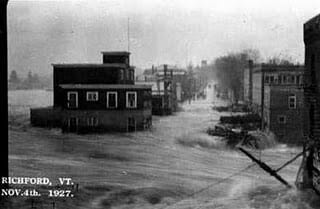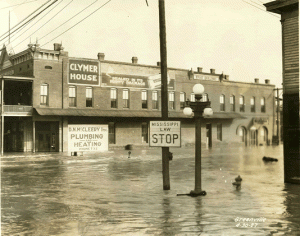 1927 was a banner year in a banner decade of American history. It was a time of growing prosperity that seemed to have no limits. Astounding inventions had changed everything, making life easier for all. Trains, cars, and even airplanes were everywhere. It was a golden age. Most people know that didn’t last. Some of us are children of the children of the Great Depression and have heard stories of the misery that followed the collapse of the American economic system. But few have heard of the natural disaster that might have been God’s wake up call to what was about to occur.
1927 was a banner year in a banner decade of American history. It was a time of growing prosperity that seemed to have no limits. Astounding inventions had changed everything, making life easier for all. Trains, cars, and even airplanes were everywhere. It was a golden age. Most people know that didn’t last. Some of us are children of the children of the Great Depression and have heard stories of the misery that followed the collapse of the American economic system. But few have heard of the natural disaster that might have been God’s wake up call to what was about to occur.
Far from Wall Street, on the flat delta land with its rich black soil, Greenville, Mississippi was enjoying its own golden age. Millionaires were aplenty, created mainly on the backs of the delta’s second greatest resource, cheap uneducated labor. Still not recovered from the War Between the States and Reconstruction, the region had very little middle class. But things were changing. The 20s brought promise of the average man beginning to make his own way without living in indebtedness to the rich.
 And then, just as things were looking up for the man in the middle, the rains came. The spring of 1927 saw rains in biblical proportions. It fell throughout the entire Mississippi River Valley, from the Appalachians to the Rockies, causing widespread flooding that made 1927 the worst year on record, before or after. The Great Flood of ’27 brought more water, more destruction, and more death than America has ever seen in a natural disaster. Katrina pales in comparison to the misery that made Greenville, Mississippi its epicenter.
And then, just as things were looking up for the man in the middle, the rains came. The spring of 1927 saw rains in biblical proportions. It fell throughout the entire Mississippi River Valley, from the Appalachians to the Rockies, causing widespread flooding that made 1927 the worst year on record, before or after. The Great Flood of ’27 brought more water, more destruction, and more death than America has ever seen in a natural disaster. Katrina pales in comparison to the misery that made Greenville, Mississippi its epicenter.
In his award winning book, The Great Mississippi Flood and How it Changed America (Simon and Schuster), John Barry chronicles the disaster itself and the man-made events that followed. It was the perfect storm of natural and human events that has left its imprint on the political map of America to this day.
The Natural Disaster
On Good Friday, April 15, 1927, the Memphis Commercial Appeal warned: “The roaring Mississippi River, bank and levee full from St. Louis to New Orleans, is believed to be on its mightiest rampage….All along the Mississippi considerable fear is felt over the prospects for the greatest flood in history.” The paper was right in its prediction. Rains fell in record proportions on an area covering hundreds of thousands of square miles. In one weekend record rainfalls were recorded in Missouri, Illinois, Arkansas, Mississippi, Texas, and Louisiana.
 Down river, New Orleans saw 15 inches in 18 hours. Below the city the levees failed, and within days twenty-seven thousand square miles were covered in water. At the height of the flood, the Mississippi river was 70 miles wide. Meanwhile, further north in the Mississippi delta, the waters continued to rise. The richest farmland on the planet was one huge boiling stew of flood waters, drowning livestock, demolished buildings, and devastated hopes and dreams of a generation.
Down river, New Orleans saw 15 inches in 18 hours. Below the city the levees failed, and within days twenty-seven thousand square miles were covered in water. At the height of the flood, the Mississippi river was 70 miles wide. Meanwhile, further north in the Mississippi delta, the waters continued to rise. The richest farmland on the planet was one huge boiling stew of flood waters, drowning livestock, demolished buildings, and devastated hopes and dreams of a generation.
Man-Made Problems
With their vast acreage under water and their city about to follow, the city fathers of Greenville called on former Mississippi Senator Le Roy Percy to save the day. His answer was to set up what amounted to concentration camps on the levies protecting Greenville and conscripting thousands of black plantation workers to live in the camps as they labored to shore up the levees.
In spite of the efforts of what amounted to slave labor, the River would not be held back. Just upriver of the city a channel broke through the levees with water flow double that of Niagara Falls. Within 10 days one million acres of prime cotton land was covered in 10 feet of water. That channel continued to empty the Mississippi beyond its banks for almost four months.
How the wealthy planters reacted is a sad page in the history of the nation. In spite of some valiant white land owners who protested, the majority of land owners feared the black workers would flee and never come back to provide their cheap labor. They knew that if the blacks got out of the Delta, they would never return. Ironically, when the first cotton picking machines came to the Delta in 1945, the same planters were buying one-way tickets to Chicago for the blacks because they didn’t need them anymore.
Back in New Orleans, it wasn’t poor blacks that suffered but rather rural whites. The wealthy of the Crescent City appealed to the federal government to basically sacrifice the parishes south of the city by blowing up an earthen levee and diverting the water to marshland. They promised restitution to people who would lose their homes. Government officials, including Commerce Secretary Herbert Hoover, signed off. New Orleans was saved, but the misery of the flooded parishes had only started. Poorer land owners who were promised aid from losing their land to save the city saw little in way of restitution.
In Washington, President Coolidge did nothing. He ignored pleas from governors and mayors in the flooded states and refused to visit the area. Several biographers have noted that Coolidge had a disdain for the South and had sworn to never cross the Mason-Dixon Line. At the same time, Hoover became somewhat of a hero and rode those waves of popular recognition to the White House in 1928. Cooldige’s refusal to help and Hoover’s failure during the economic disaster of 1929, combined with the devastation of the southern states ensured Republicans would need another 60 years before someone like Ronald Reagan could again hope for votes in the region.
The Great Flood of 1927 was a natural disaster, but what followed was a man-made tsunami of greed, bigotry, and opportunism.
____________________________________________________










